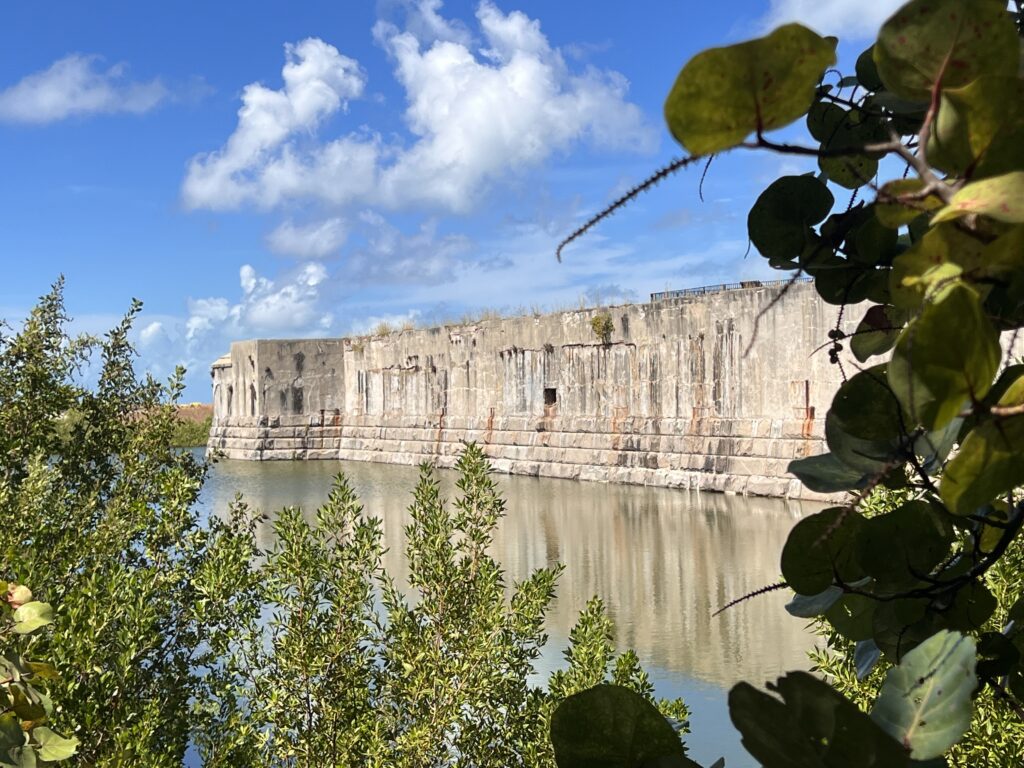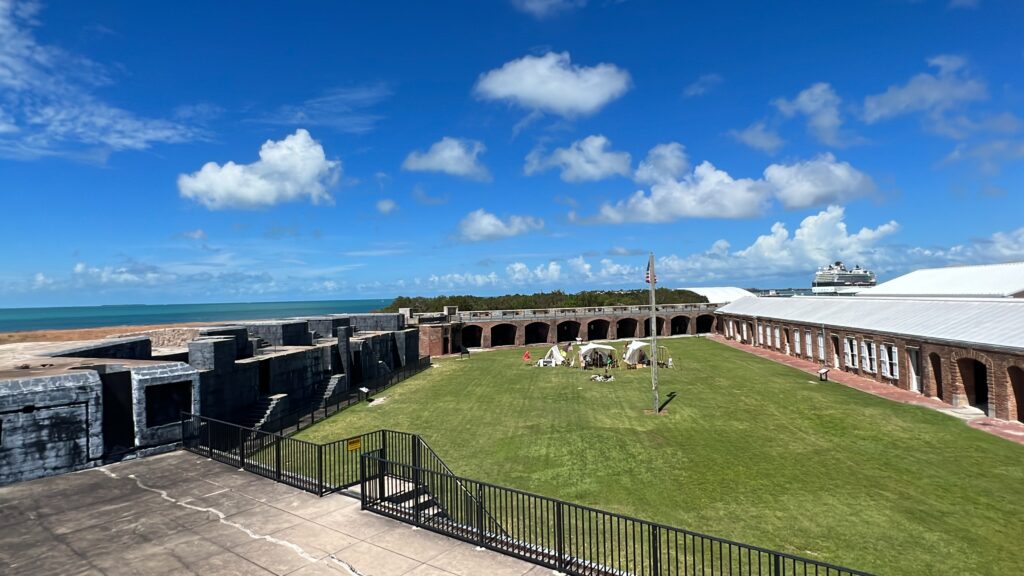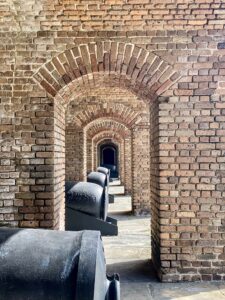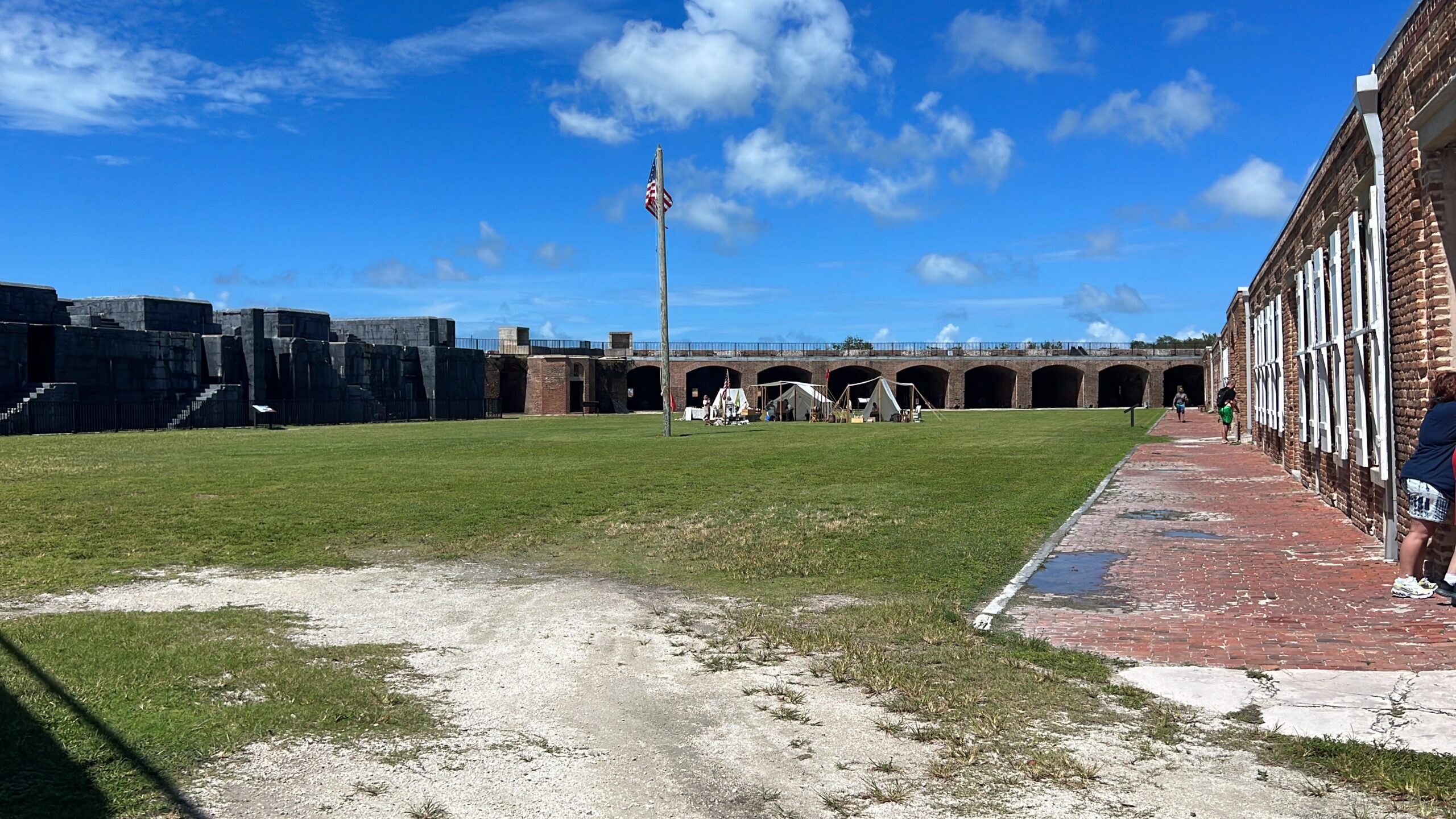Fort Zachary Taylor, a historic gem nestled in the heart of Key West, Florida. This magnificent fortress has stood tall for nearly two centuries, playing a crucial role in defending United States interests against European powers in the Western Hemisphere. Today, it stands not only as a piece of history but also as a picturesque attraction drawing in tourists to the nearby beaches and history lovers to the well-preserved fort.
Disclosure: Some links on our site are affiliate links. If you purchase a linked item, we will make a commission, at no extra charge to you.
Today, it stands watch over tourists and recreational boaters coming to Key West to enjoy the sun. Cruise ships pass by just as sailing ships would have nearly two-hundred years ago. But no longer does a three-story fort armed with 140 guns stand guard over this strategic harbor. Positioned at the confluence of the Gulf of Mexico and the Atlantic Ocean, Fort Zachary Taylor defended the United States’ interests against European powers in the Western Hemisphere.

Table of Contents
Florida Keys: Discovery and History
The story of Fort Zachary Taylor begins amidst the captivating history of the Florida Keys. Spanish explorer Ponce de Leon claimed the island chain for Spain in 1513, calling them Los Martires (The Martyrs) because he thought they looked like suffering men from a distance. But in the late 1700s and early 1800s, territorial rights to the Keys were unsettled. During the French and Indian War (Seven Years’ War), the British captured Spanish Cuba and the Philippines. To regain these colonies, the Spanish gave up control of Florida. The First Treaty of Paris, signed on February 10, 1763, gave all of Florida to England. But Spain still contended that the Keys were part of Cuba. After the American Revolution, England had little interest in keeping Florida. So another Treaty of Paris is signed on September 3, 1783, recognizing American Independence. A separate treaty ceded control of Florida back to Spain in exchange for the Bahaman Islands.
In 1815, the Governor of Havana deeded Cayo Hueso, now Key West, to Juan Pablo Salas. Salas was an officer with the Royal Spanish Navy Artillery posted in St. Augustine, Florida. They remained under Spanish control until John W. Simonton, from Alabama, bought Key West for $2,000, in 1821. But when Spain ceded control of Florida to the United States as part of the Onis-Adams Treaty, Commodore M.C. Perry, USN, took control of the island for the US. On March 25, 1822, he planted the US flag on what would first be called Thompson’s Island. Named after Secretary of the Navy Smith Thompson. The name would not stick and soon the i sland became known as Key West.
Throughout the history of the Florida Keys, Key West’s deepwater port was attractive to pirates such as Blackbeard and Jean Lafitte. Privacy was such a problem that the government sent Commodore David Porter to put an end to it, establishing his home port on the island. As piracy was eliminated, wrecking and salvage became the main occupation of those living on the island. This industry made Key West the richest city per capita in the United States.
Fort Taylor During the Civil War
Construction of the fort began in 1845, shortly after Florida became a state on March 3rd. It was eventually named for President Zachary Taylor who fell ill and died suddenly on July 9th, 1850. Due to its remoteness, shortages in material and men, Yellow fever, and hurricanes slowing progress, the fort wasn’t completed until 1866.
In the middle of the 19th Century, tensions were rising between the North and South, and the Civil War was on the horizon. The importance of the fort was not lost on either side and led to the Lewisburg (PA) Chronicle’s Key West correspondent to contend that, “In the case of a war with any maritime nation, the possession of Key West will be invaluable to us, both as a safe retreat for our merchantmen, and as a convenient harbor for men-of-war to recruit or get coal, water, and sea stores.” In January 1861, with secession and the imminent start to the war, the Weekly Mississippian argued that Fort Taylor’s importance couldn’t be “too highly estimated” and must “be taken possession of without delay by the Southern troops.”
This realization came to late as Captain John Brannan, 1st U.S. Artillery, and Captain Edward Hunt, Chief of Engineers, secured the fort for the Union. After news of Florida’s secession on January 10 reached Key West on January 12, Captain Brannan moved his troops during the night from the barracks across the island to the fort. This bold move garnered praise from the North. As one editor proclaimed “The United States should never let this work go to Florida,” since “it concerns the commerce of the United States, and is no local fortress.” New York Times editor Henry Raymond argued to the Republican Club on February 26, 1861, that the Union should keep all of its’ coastal forts. “Especially those which control the great channels of commerce.” While he did not want to see Fort Sumter fall into Confederate hands, he considered it “of no practical importance” like Fort Taylor.
But Key West before and during the war was filled with secessionists and subduing them was a major mission of the fort’s soldiers. The Key of the Gulf denounced Captain Hunt’s proclamation that he would turn Fort Taylor’s guns on the town if they did not “behave themselves to his liking.” On May 10, 1861, US authorities declare martial law. Major William French, commanding officer at Key West, took action to discourage Secessionists. This included removing all seditious and disaffected persons. Those who remained had to adjust to military occupation. A variety of Union enemies, both from the island and beyond, experienced imprisonment at Fort Taylor, including blockade runners and individuals suspected of, or who committed actual acts, of disloyalty and challenged martial law. The fort also held prisoners awaiting transfer to other locations or court martial.
It wasn’t only Confederate prisoners or sympathizers that were imprisoned in Fort Taylor. Occasionally, unruly Union soldiers from the mainland were sentenced to imprisonment at Key West. On June 2, 1862, twenty-four men from the Engineering Department, under the command of General David Hunter at Port Royal, South Carolina, arrived at Key West. The men had struck for higher wages and refused to work until their demands were met. While they were held at Fort Taylor, a military guard would escort them to town to perform their “appointed labor for the day” on the public works as punishment, instead of for pay. In January 1864, several northern dissidents served sentences at Fort Taylor. Authorities arrested these draft resistors during the July 1863 New York Draft Riots and sentenced them to hard labor at Fort Taylor and Key West’s two Martello towers. The prisoners vowed to “rule Key West” and, upon arrival, attacked a gentleman, abused his servants, stoned his house, and threatened his wife. They were then sentenced to six months imprisonment at hard labor at Fort Jefferson.
The fort’s main role during the Civil War was to serve as headquarters for the U.S. Navy’s East Gulf Coast blockade squadron. The squadron kept numerous supply ships from reaching and leaving Confederate ports in the Gulf of Mexico. While Fort Taylor never fired a shot in anger, many historians have argued that because of its mission, the Civil War did not continue any longer than it did. The fort’s armaments, 10-inch Rodman and Columbiad cannons had a range of three miles. This prevented the Confederate Navy from attempting to take the fortress or the island of Key West.
When the fort was finally finished in 1866, there were many impressive features included. Such as sanitary facilities flushed by the tide and a desalination plant, which produced drinking water from the sea.
In 1889, with the advent of rifled artillery, many masonry forts were becoming obsolete. And a modernization project was started. This included removing the top two floors of the fort. The material, including the cannons, was used to fill in the casements. It is believed this was to strengthen the outer walls of the fort. From a defensive perspective, the shorter defensive walls were less of a target on the horizon. All of this was a part of the Endicott Era of Defenses. This system, constructed from 1890-1910, was created to attack enemy warships from fortifications mounted in concrete that were not visible from the water. This tactic would stop an invasion and allow Navy vessels the time necessary to reach and engage the enemy.

USS Maine
The USS Maine sailed from here in January 1898, on her way to Havana, Cuba. She was to protect United States interests during the Cuban War of Independence. On February 15, an explosion rocked the ship killing a great majority of her crew. This event was the catalyst for the US joining the War. But we know it as the Spanish-American War.
The Coast Artillery Modernization Program came to Fort Taylor and Key West during World War II with the construction of two more gun batteries. Additionally, two Anti-Torpedo Motor Boat (AMTB) batteries were installed with the dual mission of anti-aircraft and torpedo motorboat defense. Additional defensive equipment including searchlights and radar were employed at Fort Taylor and sub-posts. These additions were to again protect the southern United States and the shipping lanes through the Florida Straights.

Fort Taylor’s Decommissioning
The fort remained in operation until 1947 when it was decommissioned and ownership was turned over to the Navy. It was placed on the National Register of Historic Places in 1971 and was designated a National Historic Landmark in 1973. Today, it sits on 87 acres of parkland and is known as the best beach in Key West.
While the fort’s look and use have changed drastically over the nearly 180 years since its inception, its service to the nation should never be forgotten. Soldiers were prepared to defend our nation during four wars. Ready to answer the call should it ever be necessary.
Visiting Fort Zachary Taylor State Park
A trip to Fort Zachary Taylor State Park promises a journey into the annals of American history. As you explore the well-preserved fort, you will be transported back to a time when soldiers stood ready to defend the nation during times of strife. This historical gem, surrounded by the beauty of Key West, remains a testament to the enduring spirit and resilience of the United States.
There are more things to do at Fort Zachary Taylor. The park also features one of the few beaches in Key West. The beach is open for swimming, sunbathing, and picnicking. There are also hiking and biking trails, a playground, and a concession stand in the park.
Here are some additional details:
- The park is open from 8 am to sunset daily. (Tip: It is a great place to watch a Key West sunset!)
- Admission is $6 for adults, $4 for seniors and children ages 6-12, and free for children under 6.
- There is a parking fee of $2 per hour or $10 for the day.
- The fort is open for tours from 9 am to 4 pm daily.
Stroll Through Fort Zachary Taylor with us
Don’t forget to subscribe to join the journey for future videos on travel and history!

